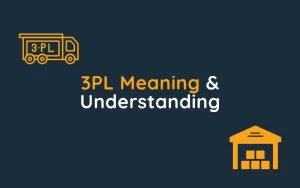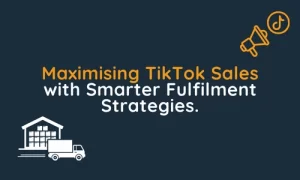In today’s fast-paced eCommerce world, fulfilment centres play a critical role in ensuring that customers receive their orders quickly and efficiently. These facilities are designed to handle every step of the order fulfilment process, from storing inventory to picking, packing, and shipping products. But how exactly do fulfilment centres work, and how do they differ from traditional warehouses?
Defining Fulfilment Centres
Fulfilment centres, also sometimes referred to as distribution centres are the heart of eCommerce operations. These specialised facilities handle everything from receiving and storing inventory to picking, packing, and shipping orders directly to customers. They’re designed for speed and efficiency, ensuring that customers get their orders as quickly as possible. In a world where same-day delivery is a priority, fulfilment centres have become more essential than ever.
To paint a clearer picture, imagine the complex process involved in processing an online order. As soon as a customer clicks ‘buy,’ the distribution centre swings into action. Inventory systems are updated in real-time to reflect the sale, and the order is transmitted to the nearest fulfilment center that has the item in stock. Employees or automated systems then locate the item, pick it from the shelf, and send it to the packing area. After being securely packaged, the item is labeled and handed off to a carrier service, all within a matter of hours.
Fulfilment centres also handle returns and exchanges, further enhancing customer satisfaction. By providing a smooth returns process, they help maintain the trust and loyalty of consumers.
You can learn more about how fulfilment centres support business growth in this post: How Fulfilment Centres Support Business Growth.
Key Functions of Fulfilment Centres
Now we’ve defined what Fulfilment centres are, lets dive into the key functions of them, and explain why they are vital in the world of supply chain.
Receiving and Inventory Management:
Distribution centres excel at receiving goods from suppliers, verifying their accuracy, and cataloguing them in inventory management systems. This ensures that each product is accurately tracked and easily accessible for order processing.
Order Picking and Packing:
Efficient picking systems, often supported by automation and advanced software, enable fulfilment centres to quickly and accurately pick products from storage. Once picked, items are carefully packed to ensure they arrive at the customer’s doorstep in perfect condition.
Shipping in Distribution Centres:
Coordinating with various carriers, distribution centres manage the entire shipping process to ensure timely delivery. They often negotiate bulk shipping rates, helping to reduce costs while maintaining fast delivery times.
Returns Management:
Handling returns efficiently is crucial for customer satisfaction. Fulfilment centres process returns quickly, inspecting and restocking items as needed, and issuing refunds or replacements promptly.
Fulfilment Centres vs Warehouses
While both fulfilment centres and warehouses store products, their roles within the supply chain differ significantly:
Warehouses: Primarily used for long-term storage, warehouses hold products until they are needed. They are static environments where inventory remains until dispatched in bulk quantities.
Fulfilment Centres: These facilities are dynamic, focusing on the rapid turnover of inventory. They handle individual orders, process shipments directly to consumers, and manage various aspects of the customer experience, including returns.
Understanding these distinctions is vital for businesses to choose the right logistics solution that aligns with their operational needs and customer service objectives.
Amazon Fulfilment Centres
Amazon operates one of the largest fulfilment networks through its Fulfilment by Amazon (FBA) program. Sellers using FBA store their inventory in Amazon’s fulfilment centres, where Amazon handles everything from picking and packing to shipping and customer service.
While FBA offers fast shipping, Prime eligibility, and customer support, it also comes with high storage fees, strict requirements, and limited control over inventory. Sellers who want more flexibility and cost control often look for alternatives, such as Seller Fulfilled Prime (SFP) or third-party logistics (3PL) providers.
TikTok Fulfilment Centres
TikTok is not just a social media platform anymore—it’s now a major player in eCommerce. With the rise of TikTok Shop, the company has launched its own fulfilment centres to help sellers process and ship orders directly from its platform.
How TikTok Fulfilment Centres Work
TikTok’s Fulfilment centres function similarly to Amazon’s FBA model. Sellers store their products in TikTok-Operated warehouses, and once a customer places an order, TikTok handles picking, packing and shipping.
Benefits of TikTok Fulfilment Centres
Fast Shipping: Orders are processed quickly to compete with major eCommerce platforms.
Integrated with TikTok Shop: Sellers can manage everything from one platform, streamlining sales and logistics.
Customer Support and Returns: TikTok handles customer inquiries and returns, making it easier for sellers to manage their businesses.
However, like Amazon FBA, TikTok’s fulfilment service comes with its own challenges, including strict storage fees and limited control over branding and packaging. This makes third-party fulfilment providers a better option for sellers who want more flexibility and cost control.
Partnering With PackPro
Choosing the right fulfilment centre involves evaluating these cost considerations alongside your business needs and growth objectives. Transparency in pricing and services is crucial for making informed decisions that optimise logistics operations and support long-term success in the competitive eCommerce landscape.
At PackPro Fulfilment, a leading UK 3PL and fulfilment centre in Essex, we are very transparent about our 3PL costs and services, ensuring businesses have clarity and confidence in their fulfilment operations. Our tailored solutions and advanced technologies help businesses make processes more efficient, reduce costs, and deliver exceptional service to their customers.
Related Blogs:



